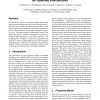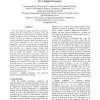561 search results - page 21 / 113 » Alias Analysis of Executable Code |
ICCAD
2001
IEEE
14 years 5 months ago
2001
IEEE
The aim of this work is to provide an elegant and accurate static execution timing model for 32-bit microprocessor instruction sets, covering also inter–instruction effects. Suc...
ICSE
2010
IEEE-ACM
14 years 1 months ago
2010
IEEE-ACM
Searching for applications that are highly relevant to development tasks is challenging because the high-level intent reflected in the descriptions of these tasks doesn’t usual...
WCRE
2010
IEEE
13 years 7 months ago
2010
IEEE
—An important application of binary-level reverse engineering is in reconstructing the internal logic of computer malware. Most malware code is distributed in encrypted (or “pa...
EMSOFT
2007
Springer
14 years 2 months ago
2007
Springer
This paper describes techniques to estimate the worst case execution time of executable code on architectures with data caches. The underlying mechanism is Abstract Interpretation...
IRI
2006
IEEE
14 years 2 months ago
2006
IEEE
With the rapidly increasing complexity of computer systems and the sophistication of hacking tools and techniques, there is a crucial need for computer forensic analysis technique...


